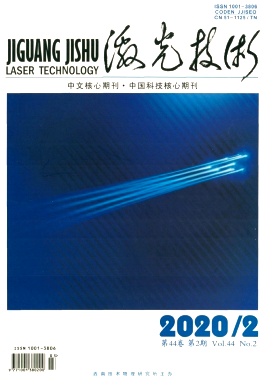HTML
-
乙酸乙酯是形成白酒香气的重要成分,同时也是一种用途广泛的精细化工产品,常作为工业溶剂、香料原料和萃取剂,并普遍应用在印刷油墨、人造革、人造纤维、染料涂料、粘合剂、人造香精等产品的生产中。由于乙酸乙酯具有良好的溶解性,常常作为溶剂进行有机合成实验、生化研究和蛋白质顺序分析。
有关乙酸乙酯的研究主要是将其作为溶剂或萃取剂来研究溶质分子的特性[1-4],而对乙酸乙酯自身的研究工作有:LIU等人利用自行研制的光纤探头结合喇曼光谱装置,实现对乙酸乙酯合成过程的实时监测[5]; TAN等人采用近红外光谱结合区间偏最小二乘法对白酒中乙酸乙酯含量最优波长区间进行确定,并建立了预测模型[6]; FENG等人采用气相色谱-质谱联用技术鉴定杜康酒中的乙酸乙酯和己酸乙酯等含量较高的香气成分[7]; SUN等人利用傅里叶变换红外光谱和衰减全反射技术结合化学计量学方法对酯类物质进行快速定性和定量分析[8]; KOLLING等人利用红外光谱技术研究非质子溶剂对乙酸乙酯羰基吸收峰的影响[9]。总体来看,国内外对乙酸乙酯的振动光谱并结合算法进行定量预测方面的研究相对较多,但外界环境变化对乙酸乙酯自身光谱特性的影响相对较少。本文中通过实验结合量子化学计算研究模拟白酒环境中乙酸乙酯稳态及瞬态荧光光谱特性的变化,有助于丰富白酒光谱特性[10]的研究和了解环境对有机分子光学性质的影响。
-
乙酸乙酯为国家标准物质研究中心提供的光谱纯,纯度不小于99.5%;乙醇为国药集团化学试剂有限公司提供的分析纯,纯度不小于99.75%;水为超纯水。
-
采用英国Edinburgh FLS920P型稳态和时间分辨荧光光谱仪测得样品的稳态荧光光谱和荧光衰减曲线。测量稳态荧光光谱时,设定激发波长为374nm,扫描波长范围为390nm~600nm,扫描间隔为1nm,激发和发射狭缝宽度均设置为5nm,积分时间设置为0.1s。测量荧光衰减曲线时,系统利用时间相关单光子计数技术,激发光源为中心波长为374nm的半导体激光器,脉冲宽度为57.7ps,测量的总光子数为10000,测量的时间范围为0ns~50ns。
1.1. 实验样品
1.2. 实验仪器
-
由图 1a可知,在374nm激发下,纯乙酸乙酯溶液的荧光光谱中荧光峰分别位于407nm和431nm。为了获得乙酸乙酯的时间分辨荧光光谱特征,固定荧光发射波长,测得乙酸乙酯在407nm和431nm处的荧光衰减曲线,如图 1b所示。两处荧光峰的衰减曲线重合,说明衰减规律基本相同。图中黑色实线为仪器响应函数(instrument response function, IRF)曲线,实验中测得的荧光衰减曲线为体系实际衰减曲线与仪器响应函数曲线卷积的结果。将测得的荧光衰减曲线通过去卷积和指数函数拟合后,利用平均寿命计算公式求得乙酸乙酯在荧光峰处的荧光寿命。本文中均使用双指数函数$I(\lambda , t) = \sum\limits_{i = 1}^2 {{a_i}} (\lambda ){{\rm{e}}^{ - t/{\tau _i}}} $来拟合荧光衰减曲线,ai为各组分寿命比重,τi为各组分的荧光寿命,λ为荧光峰值波长,t为时间,拟合过程中均方根χ2值在0.9~1.2范围内,荧光平均寿命计算公式为$ \hat \tau = \sum\limits_{i = 1}^2 {{a_i}} \tau _i^2/\sum\limits_{i = 1}^2 {{a_i}} {\tau _i}$,乙酸乙酯在两处荧光峰的荧光寿命及其成分比重列于表 1中。由表可知,乙酸乙酯两个成分的寿命数值相近,拟合后计算的平均寿命约为1.4ns。

Figure 1. a—fluorescence spectra of ethyl acetate excited at 374nm b—fluorescence decay curves of ethyl acetate at 407nm and 431nm
emission wavelength/nm τ1/ns a1/% τ2/ns a2/% ${\hat \tau } $ /ns χ2 407 1.12 59.11 1.66 40.89 1.393 0.924 431 1.25 89.76 2.16 10.24 1.399 0.952 Table 1. Fluorescence lifetime and proportion of ethyl acetate
-
将乙醇溶于超纯水中,配制成体积分数为0.5的乙醇水溶液来模拟白酒环境。将乙酸乙酯溶于乙醇水溶液中,分别配制成体积分数为0.1, 0.2, 0.3, 0.4, 0.5, 0.6, 0.7, 0.8和0.9的乙酸乙酯乙醇水溶液,以考察模拟白酒环境对乙酸乙酯荧光寿命的影响。设定激发波长为374nm,扫描波长范围为390nm~600nm,扫描间隔为1nm,积分时间为0.1s,测量不同体积分数乙酸乙酯乙醇水溶液的荧光光谱,结果如图 2a所示。

Figure 2. a—fluorescence spectra of ethyl acetate ethanol aqueous solutions with different volume fractions b—fluorescence decay curves of ethyl acetate ethanol aqueous solutions with different volume fractions at 404nm c—fluorescence decay curves at 431nm
由图 2a可知,不同体积分数的乙酸乙酯乙醇水溶液的荧光峰有少许的位移,分别在407nm~412nm和431nm~434nm范围变动。随着乙醇水溶液的体积增加,荧光强度逐渐减小。一是由于荧光物质乙酸乙酯的减少,二可能是由于乙醇和水溶液的引入,分子间的相互作用有了新的变化:乙酸乙酯和乙醇、水分子之间形成多聚体结构。分别在不同体积分数样品的荧光峰处测得时间分辨荧光光谱,考察乙醇和水对乙酸乙酯动力学性质的影响。图 2b和图 2c中分别是不同体积分数乙酸乙酯乙醇溶液在各自荧光峰处的荧光衰减曲线,衰减曲线的拟合结果和荧光寿命列于表 2中。
volume fraction emission wavelength/nm τ1/ns a1/% τ2/ns a2/% ${\hat \tau } $ /ns χ2 0.1 412 1.64 88.86 14.86 11.14 8.67 1.075 434 1.67 87.84 15.02 12.16 9.07 1.137 0.2 412 1.58 93.97 12.76 6.03 5.40 1.108 434 1.6 94.17 13.07 5.83 5.45 1.197 0.3 411 1.56 95.75 11.93 4.25 4.19 1.076 434 1.57 96.21 11.74 3.79 3.88 1.164 0.4 410 1.52 95.75 9.92 2.82 2.86 1.109 434 1.53 97.44 9.73 2.56 2.7 1.114 0.5 410 1.49 97.45 8 2.55 2.29 1.097 434 1.5 97.78 8.55 2.22 2.31 1.094 0.6 409 1.44 97.73 5.43 2.27 1.76 0.913 433 1.45 98.09 5.91 1.91 1.78 0.98 0.7 408 1.42 97.92 4.69 2.08 1.63 0.933 432 1.43 97.99 4.86 2.01 1.65 1.002 0.8 408 1.38 96.9 3.46 3.1 1.53 0.971 431 1.39 97.91 4.21 2.09 1.56 0.985 0.9 407 1.35 96.81 3.19 3.19 1.47 0.930 431 1.34 95.23 2.89 4.77 1.49 0.963 Table 2. Fluorescence lifetime and proportion of ethyl acetate ethanol aqueous solution with different volume fractions
由表中数据可知,在两处荧光峰衰减过程中,短寿命成分所占比重最大,基本在1.3ns~1.6ns范围内,与乙酸乙酯的荧光寿命结果接近,说明荧光寿命不易受荧光分子含量的影响。而长寿命成分的寿命值随着乙醇水溶液体积分数的增加也逐渐增大,且在体积比为50%乙酸乙酯乙醇水溶液时,该成分寿命值增幅较大,样品的平均寿命值也在不断增大。这可能是由于水分子的加入,使得乙酸乙酯和乙醇分子的多聚体结构出现新的多聚体形式,从而出现不同的荧光发射形式。
-
通过量子化学计算,研究乙酸乙酯和乙醇、水分子之间的多聚体模型。首先通过定量分子表面分析来预测分子间反应位点及结合模式,此处主要分析的是静电势[14]在分子范德华表面的分布。采用B3LYP泛函,在6-31G(d, p)基组水平对乙酸乙酯、乙醇和水分子进行表面静电势分布进行计算,从而判断分子间结合位点。图 3a~图 3c分别为乙酸乙酯、乙醇和水分子的表面静电势分布图。图中越蓝色的区域表示静电势越负,越红色区域表示静电势越正,白色区域的静电势数值在0附近。由图可知,乙酸乙酯酯基上的双键氧原子处存在静电势极小值点,而单键氧原子由于被正静电势的碳原子包裹而未表现出较强的负电性,表明氧原子上的孤对电子对静电势有很大的负贡献,静电势正值区域在碳链表面分布较为均匀;同理,乙醇羟基上的氧原子由于孤对电子的存在而显示很强的负电性,而氢原子由于电负性小于碳、氧原子,因此在体系中显现正电性;且羟基上的氢原子,由于所连的氧原子比碳原子的吸引电子能力更强而显示明显的正电性,对应体系中静电势极大值点;与乙醇相似,水由于氧原子两端连有等价的氢原子,所以两个氢原子均为体系中静电势极大值点。

Figure 3. a—electrostatic potential of ethyl acetate molecule surface b—electrostatic potential of ethanol molecule surface c—electrostatic potential of water molecule surface
通过极值点分析可知,乙酸乙酯的酯基双键氧对应表面静电势最小值点,乙醇的羟基氢原子和水分子的两个氢原子对应静电势最大值点,因此3个分子容易通过静电相互作用结合成多聚体结构,使得多聚体能量最大程度的降低,结构处于稳定状态。
-
考虑乙醇和水分子对乙酸乙酯的影响,构建两种多聚体结构,分别是乙酸乙酯与一个乙醇和水分子的三聚体结构和两个乙酸乙酯与两个乙醇和水分子的六聚体结构,如图 4a和图 4b所示。在与静电势分布计算相同的泛函和基组水平,对两者进行结构优化。优化结果无虚频,表面结构处于势能面能量最低点。

Figure 4. a—trimer structure of ethyl acetate and ethanol water molecule b—hexamer structure of ethyl acetate and ethanol water molecule
基于约化密度梯度函数(reduced density gradient,RDG)和电子密度ρ之间的关系,YANG课题组开发出一种有效而便捷的方法来研究弱相互作用,称为RDG方法[15],该方法在研究有机分子结构方面得到广泛的应用[16-20]。通过绘制RDG和ρ乘以电子密度Hessian矩阵的第二大本征值函数sign(λ2)乘积之间的散点图,并将该函数乘积sign(λ2)ρ投影到RDG等值面上,就可以在实空间中表征各种类型和强度的弱相互作用,研究对象主要是氢键、范德华力和位阻作用。RDG填色等值面图中左侧蓝色区域表示较强、起吸引作用的弱相互作用,即氢键;中间绿色区域表示相互作用强度较弱的范德华作用;右侧红色区域表示有互斥作用的位阻效应。散点图上也出现若干垂直于横坐标的“尖钉”,原文中称为spike。spike上的点正对应于弱相互作用区域,散点图上各个spike位置和RDG填色图上的等值面通过颜色进行一一对应。图 5a和图 5b分别是三聚体结构的RDG填色等值面图和散点图。图 6a和图 6b分别是六聚体结构的RDG填色等值面图和散点图。

Figure 5. a—RDG coloring contours of trimer structure b—RDG coloring scatter plot of trimer structure
由图 5a可知,乙酸乙酯酯基上的双键氧原子与乙醇分子、水分子的氢原子存在蓝色的等值面为氢键,表明三者是以氢键作用结合,且乙醇和水分子之间的氢键作用最强,对应散点图最左侧垂直于x轴的spike,对应横坐标-0.027a.u.;乙醇与乙酸乙酯之间的氢键作用对应横坐标为-0.025a.u.的spike,而水与乙酸乙酯之间等值面颜色偏绿色,更接近分子间的范德华作用。在三聚体结构中,由于水分子的加入,使得该多聚体的平面性得到了提高,这有利于乙酸乙酯荧光的发射过程。
而在图 6a中,两个乙酸乙酯和两个乙醇分子之间的深蓝色等值面,表示两者之间的存在强氢键作用;水分子与乙醇分子之间也存在较强的氢键作用,对应散点图中横坐标为-0.032a.u.的spike,此处的氢键强度要略高于三聚体结构中的氢键强度,而水分子与乙酸乙酯之间还是以范德华力作用为主。所以,此处的水分子由于两端均可形成氢键,可作为连接乙酸乙酯和乙醇二聚体的媒介,使得两个二聚体形成层状结构,每层都是由多个短而强的氢键和范德华力所连接,相互交织而成为有序的网络结构。该结构刚性增强,进一步阻碍分子的运动,减少激发态分子的非辐射跃迁,使得荧光寿命得到延长。
3.1. 纯乙酸乙酯荧光光谱
3.2. 不同体积分数乙酸乙酯乙醇水溶液的荧光光谱特性
3.3. 分子表面静电势
3.4. 弱相互作用可视化研究
-
实验中测得不同体积分数乙酸乙酯乙醇水溶液的时间分辨荧光光谱,发现随着乙酸乙酯体积分数的减小,混合溶液的荧光平均寿命逐渐增大。其中短寿命成分为乙酸乙酯,长寿命成分为乙酸乙酯和乙醇及水分子的多聚体结构。对乙酸乙酯进行分子表面静电势分布计算,分析可知酯基上双键氧原子为多聚体结合的反应位点。由于水分子的引入及其结构特殊性,连接乙酸乙酯和乙醇的二聚体形成层状的结构,每层之间存在多个氢键和范德华力的作用,相互交织形成有序的网络结构,形成更加刚性的分子环境,降低非辐射跃迁的几率,从而荧光寿命较长。

 Map
Map





 DownLoad:
DownLoad:




